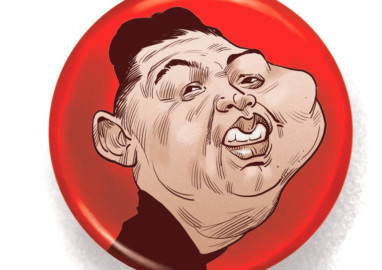
One of the best books written about North Korea is Nothing to Envy by Barbara Demick. In it, she brilliantly reconstructs the lives of ordinary people living in Chongjin, in the remote northeast of the country. I say “reconstruct” because her narrative is pieced together almost entirely from talking to exiles who managed to flee the country. Demick visited North Korea several times, but learnt little of value. “Visitors hewed to a carefully selected itinerary of monuments,” she wrote. They were assigned “minders” who ensured “there was no contact permitted with ordinary citizens”.
Until last week, I had never been to North Korea. I always felt faintly queasy opining about a country I had never set foot in. Finally, I managed to get there as part of a small delegation with the European Union (EU)-Asia Centre, a think-tank dedicated to promoting better ties between Europe and Asia. Our five-day trip took us to Pyongyang, to the demilitarised zone (DMZ) on the tense border with South Korea and to Mangyongdae, a mountainous region that is the supposed birthplace of Kim Il Sung, the nation’s founder. So what, if anything, did I learn?
The first is that Pyongyang — or at least what I was able to see of it — looks slightly less grim than I had imagined. True, many of the austere buildings have all the charm of a Soviet housing estate. True too, there are few shops to be seen. The city, designed to project power and prestige, is built on a decidedly inhuman scale. Yet, there is more bustle than you may expect. There are more cars than just a few years ago, many of them new. It is a development that has necessitated the installation of traffic lights. Many women wear high heels in a variety of fashions, imported from China and evidently not manufactured in Pyongyang Shoe Factory Number 1. There is an ice rink and a bowling alley and some pleasantly manicured parks.
Our group was barred, or otherwise dissuaded, from entering ordinary supermarkets. The few shops we did glimpse stocked a reasonable range of goods, including Japanese snacks, Dutch beer (Heineken) and Chinese instant noodles. Foreign currency is accepted. Shop assistants are able to rattle off prices in euros, renminbi and dollars — just for starters. (No mention yet of the Scottish pound). No one hides the fact they have foreign currency, even though this can only have been obtained outside the state system. Much, apparently, makes its way down what is known as “the road of life” from Dandong on the other side of the Chinese border.
One needs to be wary of impressions gleaned from Pyongyang. This is a showcase city, the home of the connected and presumably loyal elite. You have to constantly remind yourself that you are being shown the “good parts”. The rest of North Korea is, to quote resident diplomats, “another country”.
The second thing to note is the pervasive sense of victimhood. Paul French’s book North Korea: State of Paranoia is aptly named. Any conversation on a serious topic starts and ends with Pyongyang’s struggle for survival in the face of unrelenting pressure from “the imperialist US” and its “puppet” South Korean servant. The US wants to control all of northeast Asia. China wants to use North Korea as a buffer. Everyone wants to topple the Kim regime. (Just because you are paranoid, does not mean they are not out to get you.) Singled out for opprobrium are the regular US-South Korean military manoeuvres, which are deemed ample justification for Pyongyang’s nuclear weapons programme.
Even economic policy is framed in terms of external threat. That is why North Korea must be self-reliant — something it has patently failed to achieve given its dependence on outside aid. Paranoia assumes an almost surreal quality. Asked about the rate of economic growth, the head of one institute replies: “It is the policy of our party not to reveal statistics about our economy.”
A third observation, hardly surprising, is the sheer intensity of the cult of Kim. The interests of state and dynasty have merged. One senior researcher quoted a poem suggesting the Kims would rule forever. No mention of the nation’s founder is complete without the epithet “Great Leader” and no reference to his 31-year-old grandson and current ruler without a nod to “the wise leadership of the Great Marshall Kim Jong Un”. Kim badges, worn over the heart, are obligatory. So is bowing at the foot of the dynasty’s ubiquitous monuments.
Yet, in the end, Demick is right. A visit to North Korea reveals little. Our trip resembled The Truman Show, in which the protagonist is trapped in a televised soap opera. In the North Korea I visited, the food was ample, the waitresses were pretty and the soldiers at the DMZ taller than average. It was like some warped version of Garrison Keillor’s Lake Wobegon, “where all the women are strong, all the men are good looking and all the children are above average”. Except that, thanks to food shortages and a broken economic system, that is almost exactly the opposite of the truth.
— Financial Times









